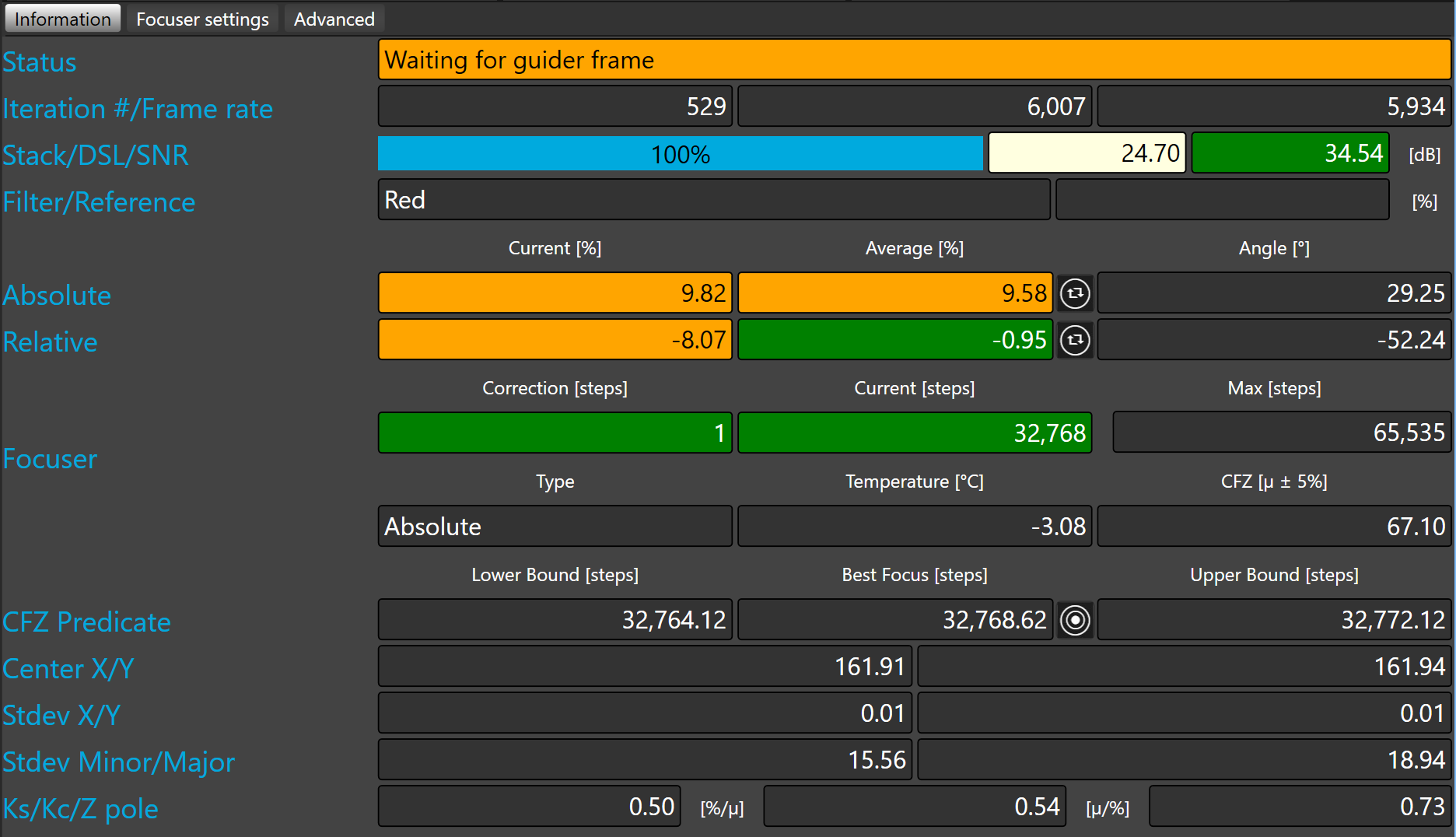Information
 Not available nor applicable with SkyGuide
Not available nor applicable with SkyGuide
The information panel shows the status of the focusing loop and all statistics about the focus errors.

Status shows the current status of the focusing loop, the following status are available:
|
Status |
Description |
|
Idle |
Focusing loop is not running |
|
Calibrating |
Calibrating focuser |
|
Analyzing |
Analyzing guider frame to measure focuss errors |
|
Moving |
Sending measured correction to the acquisition loop to move the focuser through the focuser relay |
|
Waiting for guider frame |
Focusing loop is waiting on the acquisition loop to get the next guider frame |
|
NO CORRECTION! Waiting frame |
For various reason there are no corrections available, the focusing loop is waiting for the next guider frame.
|
|
Paused |
Focusing loop has been paused. |
|
FAILED! Waiting frame |
A failure occurred in the focusing loop (check SkyGuard.log to get more information about the failure). |
|
Filter delay! Waiting frame |
Auto-focus is suspended during 10 iterations when the filter wheel has shifted to another filter. It happen only when filter delay option has been enabled. |
|
Stacking |
Focusing loop is stacking the guider frame to build the focusing input frame. |
|
POOR CORRELATION! Waiting frame |
Focusing loop has detected a correlation factor below the configured threshold.
|
|
DITHERING! Waiting frame |
Auto-focus is suspended while guiding loop is shifting the telescope to the committed dithering offset. |
Iteration #/Frame rate display the total number of frames processed by the focusing loop since it was started, the last frame rate and the average frame rate in milliseconds.
Stack/DSL/SNR display the progress of the number of frame stacked, the dynamic range and the signal to noise ratios of the stacked frame.
Filter/Reference display the name of the filter currently selected in the filter wheel and if a reference has been defined for the filter its relative roundness in percent.
The auto-focus is done by measuring the level of astigmatism caused by the NIR light going through the 45 degrees tilted beam splitter inside the ONAG® toward its guider port. There is no such aberration for the imaging camera since the visible light is reflected toward it.
This level is measured in term of roundness (RDN).
The roundness allows to measure the astigmatism caused by the IR light crossing the beam splitter inside the ONAG®.
There are two types of roundness: absolute and relative
The absolute roundness (ARDN) is always positive and it used for calibration purpose.
The relative roundness (RRDN) is a signed number carrying directional information (+/-) and it is used for the real time auto-focus operation
Both roundness values are expressed in %.
The current, the average, and the angle values are displayed for both.
The absolute (ARDN) is independent of the guider coordinate system versus the ONAG® axes relationship (ONAG's body), or angle of rotation. In other words, any guider camera rotation does not change the ARDN value. The ARDN is always a positive number.
The relative (RRDN) is related to the actual guider camera rotation.
 Prior calibrating the focuser, the guider camera mounted on the ONAG® guider port must be adjusted to reach an average absolute roundness (AARDN) value between 0 and 10%, we recommend below 5%
Prior calibrating the focuser, the guider camera mounted on the ONAG® guider port must be adjusted to reach an average absolute roundness (AARDN) value between 0 and 10%, we recommend below 5%
The  buttons allows to clear the corresponding average roundness value.
buttons allows to clear the corresponding average roundness value.
Focuser display the calculated correction in steps, the current focuser position in steps, the maximum number of steps of the absolute focuser, the focuser type (absolute/relative), the focuser temperature and the critical focus zone (CFZ) of the instrument.
CFZ Predicate shows the predicate of the critical focus zone (CFZ) in term of absolute focuser position. The best focus is at the middle of the CFZ delimited by the lower and upper bounds.
 The focuser can be moved to the best focus predicate by a simple click on the
The focuser can be moved to the best focus predicate by a simple click on the  button.
button.
Center X/Y shows the calculated centroid X and Y coordinates of the focusing correlation peak.
Stdev X/Y shows the calculated standard deviation along the X and Y axes of the focusing correlation peak.
Stdev Minor/Major shows the calculated standard deviation along the minor and major axis of the focusing correlation peak.
Ks/Kc/Z pole shows the system gains.
 The Center X/Y, Stdev S/Y, Stdev Minor/Major, Ks, Kc, and Z pole are displayed only the show detailed information is checked.
The Center X/Y, Stdev S/Y, Stdev Minor/Major, Ks, Kc, and Z pole are displayed only the show detailed information is checked.
